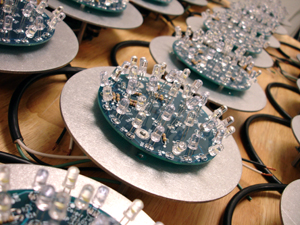Open Mike:
Houston illuminated
By Ruth E. Kott, AM'07
Image from Cooper Perkins
Artist Stephen Korns, AB'74, doesn't worry too much about having control over his work—he knows that a loss of control comes with doing outdoor art. For a 1980 project in New York City, where he's based part time, he anchored 78 amber, battery-powered "warning lights that you see on street barricades" in the Hudson River. He wasn't totally sure what would happen when he put the lights out there, he says, but "the chance drips or chance gestures" in modern art can be happy surprises—in the river installation's case, the lights blinked at slightly different rates, and the disks holding the lights would sometimes rotate. But he was more interested anyway in how people experienced the installation, what they thought he was trying to do.

For a recent project in Houston, he worked with the Buffalo Bayou Partnership to come up with a concept for lighting the bayou's new park and pedestrian and biking trails, for which he was a corecipient of an American Society of Landscape Architects Award of Excellence in Design. Completed in 2006, the lighting changes according to the phases of the moon, from blue (new moon) to white (full moon) throughout the 29-day lunar cycle (the LED arrays pictured were designed by electrical-engineering firm Cooper Perkins). The next phase of the project, still in progress, involves city-scale lighting and a sound and lighting installation under the Main Street Bridge.
Artist's statement: My work is often very difficult to distinguish from something that could be there because of engineering or some other sort of industrial purpose. But invariably, my intent is to kind of surprise people, subvert their expectations, cause them to wonder at something that's hidden, and look to the site itself for clues.
Lighting rationale: It introduces a lunar element in a city that the world knows to have sent a man to the moon, where there is no presence of NASA in downtown Houston, let alone a sense of moonlight, or any other natural light, because it's an over-lit, bleak, urban, harsh thing surrounded by oil refineries.
Site unseen: The Buffalo Bayou is almost invisible to most Houstonians, despite its flowing right through downtown because it's more or less decked over by streets.
Natural observer: I spend hours and hours and days and days walking a site and looking at it and trying to figure out what it does to me and whether I think that's worthwhile to other people, if I can reveal that to them.
Working within one's means: As an artist who works in a site-specific context or in relation to a site, you can't pretend that there isn't a freeway right in front of your house, or an ocean in your backyard.
